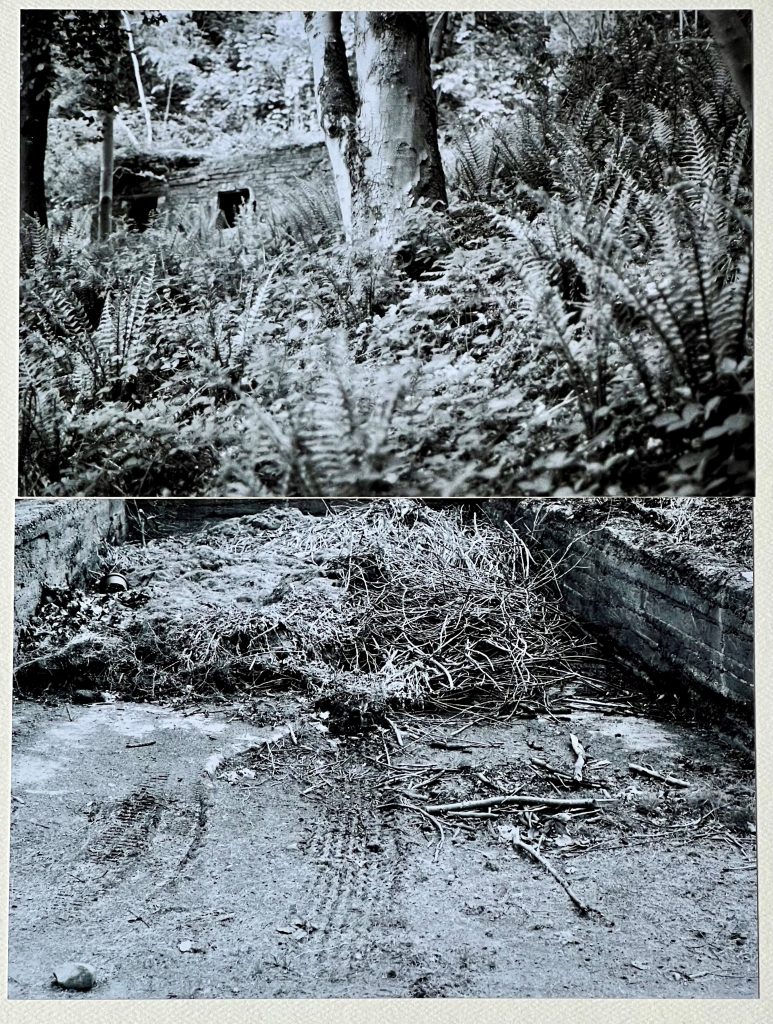Our Artist in Residence for the academic year 2023-24 is Audrey Grant. Audrey is an award-winning painter whose practice includes drawing, photography, and site-specific installation. Grant’s work is underpinned by intellectual ideas derived from, and inspired by, poetry, literature, and philosophy.
Audrey’s work will focus on the ancient Airthrey Estate where the University is located. Historic buildings, now ruinous, remain in this landscape within the lush Hermitage woods on the periphery of the modern University estate. Of the woods, she states that she will consider ‘the immensity of the forest and the hermit’s hut as a centre of concentrated solitude’: of the old and dilapidated cottages on campus ‘the house as an embodiment of dreams that collects and contains the past, present and future’: and of Logie Kirk and its ancient predecessor ‘the significance of the ruin’. Each month she will be writing a blog piece to let us know what she has been up to during the residency. Audrey says:
My Residency began with a week long stay on campus, the start of a 6 month research period exploring the rich and complex history of the Airthrey Estate. This research period would not only explore its past but also the Estate today. The week was filled with informative, inspiring, warm and friendly introductions to many academic colleagues of the Art Collection Department, these encounters opened many possibilities and the promise of further discussions to progress shared interests and similar areas of research. I came away from that week full up and brimming with possibilities.
As well as the many wonderful encounters, I walked extensively each day to discover and familiarise myself with the pathways and the rich landscape of the Airthrey Estate. I began to photograph particular areas, buildings and ruins that I was drawn to – using my iPhone camera as an aide memoire and my Nikon 35mm analogue camera for the beginnings of the artistic work. I began to build a library of images which I grouped into subjects for further investigation, to identify what might emerge and what aspects of the landscape I was drawn to.

I found myself particularly drawn to the periphery of the campus, the boundary, the
outside rather than the centre -The Hermitage Woods and its ruins – the Hermitage,
Summer House and Cistern. The walls, the endless paths, Ivy Cottage, Garden Cottage, the ice house, the almost hidden Victorian well and the Garden of Time. Places and spaces overlooked and forgotten yet their presence is still felt and visible. These beautiful and somewhat Romantic ruins, deep in the woods and often difficult to find, became a ‘found sculptural environment’ for me – the beginnings of an Artwork.
Subjects for further investigation
The French philosopher Gaston Bachelard might call these ‘praiseworthy spaces’ –
spaces that can evoke and inspire our poetical imaginations. I am interested in exploring how a deeper and empathetic experience of this landscape will become a subject for art and the powerful and poetic images may remain in our memories for a long time. An artist is most often solitary in their studio as I am but it is often through a kind of solitude that we can discover our creative possibilities – through processes of listening, thinking, reflecting, imagining and daydreaming. At present I am solitary walker through this landscape but over the coming months I hope to share and discuss these with others.
Throughout the month of May I have spent time exploring the extensive paths and ruins around the Airthrey Estate, reading and researching its history, examining old maps and papers in the Airthrey Estate Archive. My repeated walks have been rewarding and enriching, seeing the burst of growth in the woodlands especially – the rolling seas of bluebells and choruses of birdsong have been incredibly moving. I’ve also been repeatedly drawn to an area of the campus occupied by the Gardens and Grounds Department where I found great mountains of materials such as salt, soil, stone and wood -an Artist’s Paradise! Materials to build with, to cultivate with and to transform with. I’ve begun to photograph this area and to relate the images of the ruinous built environment with images from this area. For example, here are two black and white photographs (No 1) one of crumbling part of the Hermitage ruin juxtaposed with an image stone slabs and wooden pallets. The image becomes one.

Here is another (No2) of the Cistern or Filter house nestling the summer growth
juxtaposed with a sort of storage bay with dried foliage and tyre tracks.

Another (No. 3) of what was probably the fire place in the Hermitage juxtaposed with the compost soil and spade in the Ground and Gardens Department. Can you imagine a hermit sitting in their solitude, warming themself in front of the fire on a cold winter night. What do you see, feel or even hear?

These experiments in combining two photographs are now becoming imagined
landscapes – two separate images become one and what does that convey? How do they relate to each or not as the case may be and what, if anything, does the image now convey. Hopefully something for further investigation and most importantly further imagining. These are the sorts of questions I have been exploring in the first month of my Residency.

